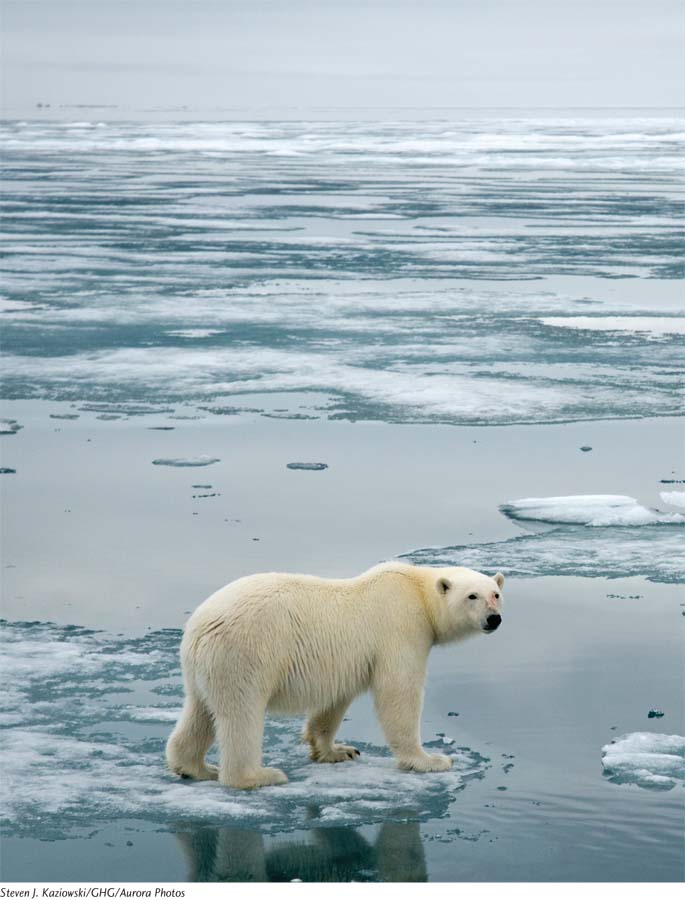Chapter Introduction
chapter 19
Global Change
663

Module 62 Global Climate Change and the Greenhouse Effect
Module 63 The Evidence for Global Warming
Module 64 The Consequences of Global Climate Change
Walking on Thin Ice
The polar bear is one of the best-
While the plight of the polar bear has drawn attention to the effects of global warming, it is only one of many indicators that our world is rapidly changing because of human activity.
Over the last few decades, temperatures in the Arctic have risen much faster than in other parts of the world. Warmer air and ocean water have caused the polar ice cap to melt, raising concern among both scientists and the general public because of both the popular appeal of the polar bear and its importance to the ecosystem and native peoples.
Scientists have been taking satellite photos of the polar ice cap for over 30 years. In 1978, photos revealed that the ice cap extended from Russia and Norway to Greenland, Canada, and Alaska. Over the years, however, the ice cap has shrunk and retreated away from the land. During each year, a natural cycle of shrinking and expansion of the polar ice cap occurs; it becomes smaller during the summer and larger during the winter. Because of the rise in Arctic temperatures, the amount of summer shrinking of the ice has increased. To measure the extent of this shrinkage, scientists compare yearly measurements taken at the end of each summer. Compared with the average amount of ice present from 1979 to 2000, scientists found that there was 45 percent less ice each year from 2006 to 2012—
664
As the polar ice cap melts, the polar bears have been losing habitat. During the summer, when the ice cap becomes unusually small and ice retreats far away from the land, polar bears can no longer reach the ice to hunt for seals. Today, the sea ice melts 3 weeks earlier than it did 30 years ago. Because of the shorter time they are able to hunt for seals, male polar bears near Hudson Bay in Canada currently weigh 67 kg (150 pounds) less than they weighed 30 years ago. Moreover, the population of polar bears living on the western side of Hudson Bay has declined by 10 percent during the past decade.
The status of polar bear populations is not easy to assess given their remote locations around the world. Of the 19 distinct populations that live in the Arctic, researchers at the International Union for the Conservation of Nature found that one is increasing, three are stable, and eight are decreasing; the remaining seven populations lack sufficient long-
A sharp decline or extinction of polar bears would have a wide range of effects on the ecosystem and on the indigenous people in the area. Seal populations could increase with the demise of their major predator, while other species, such as the Arctic fox, could decline because there would be fewer seal carcasses for them to feed on. In 2014, researchers working along the Hudson Bay found that the bears had begun to compensate for the reduced feeding on seals by changing their diets in the late summer; they started feeding more on snow geese, snow geese eggs, caribou, and even some plants. These changes in feeding patterns, in turn, should cause reverberations throughout the Arctic food web. Indigenous people would also be affected by polar bear declines, not only in terms of the food and clothing that the polar bear provides, but also from the perspective of their cultural and social identity. As the ecosystem changes with the decline of the polar bear, people of the Arctic may find their lives and livelihoods altered.
In 2008, the United States classified polar bears as a threatened species because of the decline in their ice habitat. If current conditions persist, the species will continue to decline. In 2009, the five nations with polar bear populations (Canada, Greenland, Norway, Russia, and the United States) agreed that the polar bear should be classified as threatened throughout its entire global range. While acknowledging that pollution and hunting contributed to the bears’ bleak future, the nations agreed that the effect of global warming on the ice cap poses the greatest threat to polar bears. This means that the solution to the problem is not simply in the hands of those few nations that contain polar bear habitats, but is in the hands of everyone on Earth who contributes to global warming. In 2013, the United States and Russia went a step further by announcing an agreement to push for a CITES rule to ban the international trade in all products from polar bears including furs and teeth. While the plight of the polar bear has drawn attention to the effects of global warming, it is only one of many indicators that our world is rapidly changing because of human activity.
Sources: A. Revkin, Nations near Arctic declare polar bears threatened by climate change, New York Times, March 20, 2009, http:/
The melting of the polar ice cap is just one example of many changes taking place on Earth. In this chapter, we will examine how humans have altered the world’s climate and explore the underlying causes of these climate changes. We will also investigate the observed consequences of these changes for humans and other species, and consider predictions of future consequences. This chapter ties together many of the themes we have developed throughout the book: the interconnectedness of the systems on Earth, the environmental indicators that enable us to measure and evaluate the environmental status of Earth, and the interaction of environmental science and policy.